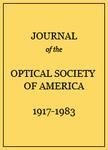版权所有:内蒙古大学图书馆 技术提供:维普资讯• 智图
内蒙古自治区呼和浩特市赛罕区大学西街235号 邮编: 010021

作者机构:Research Laboratories Eastman Kodak Company Rochester 4 New York
出 版 物:《JOURNAL OF THE OPTICAL SOCIETY OF AMERICA》
年 卷 期:1956年第46卷第5期
页 面:324-333页
核心收录:
主 题:Calibration Computation methods Fog Mathematical methods Photographic film Transforms
摘 要:The American Standard method for determining the photographic speed of negative materials, and the corresponding British Standard, specify the 0.3 G ¯ fractional-gradient criterion for measuring speed sensitometrically. This criterion was adopted because it gives speed values which correlate more closely with speeds obtained by picture tests than do the speeds obtained by any other known sensitometric speed criterion. A frequent criticism, however, of the 0.3 G ¯ criterion is that it is more difficult to operate and more subject to random errors than simpler criteria, such as the one based on a density of 0.1 above fog. In the present paper, two methods of evaluating speed are described which are simple to operate and which give highly repeatable results that agree closely with accurately measured 0.3 G ¯ speeds and with speeds based on picture tests. The first method utilizes a mathematical representation of a portion of the sensitometric curve and converts inertia speed to an approximation of 0.3 G ¯ speed by means of a measurement of the length of the toe of the curve. The second method converts the speed based on a density of 0.1 above fog to an approximation of 0.3 G ¯ speed by means of the density resulting from an exposure equal to twenty times that required for the density of 0.1 above fog. Both methods are suitable for practical use, but the first method is of particular interest in the mathematical theory of the shape of the sensitometric curve and its relation to speed. The second method is especially suited to rapid, routine determination of speeds and is adaptable to automatic computation of speeds from density measurements without the necessity of drawing the sensitometric curve.